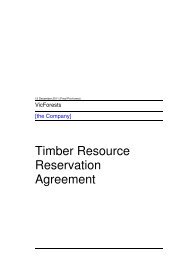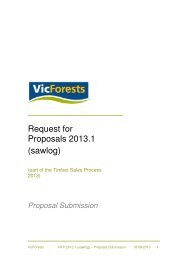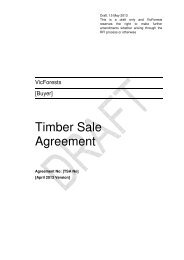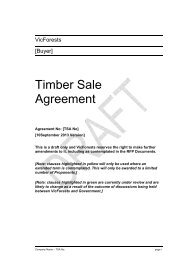- Page 1:
Report Environmental Audit - Forest
- Page 5 and 6:
Table of Contents Executive Summary
- Page 7:
Executive Summary Table 4-24 Table
- Page 11 and 12: Executive Summary This report docum
- Page 13: 0 Introduction environmental impact
- Page 16 and 17: 0 Introduction Element group (Opera
- Page 19 and 20: 1 Introduction 1 This report docume
- Page 21: 1 Introduction their objectives of
- Page 24 and 25: 2 Audit scope 2.3 Beneficial uses I
- Page 27 and 28: Audit Approach 3 3 3.1 Audit overvi
- Page 29 and 30: 3 Audit Approach Log landings and
- Page 31: 3 Audit Approach audit criteria in
- Page 34 and 35: 3 Audit Approach 4.2.1 Environmenta
- Page 36 and 37: 3 Audit Approach Major Two non-comp
- Page 38 and 39: 3 Audit Approach Details of audit f
- Page 40 and 41: 3 Audit Approach Table 4-5 summaris
- Page 42 and 43: 4 3BAudit Findings Table 4-6 Summar
- Page 44 and 45: 4 3BAudit Findings Table 4-8 Summar
- Page 46 and 47: 4 3BAudit Findings Table 4-9 Summar
- Page 48 and 49: 4 3BAudit Findings Biodiversity con
- Page 50 and 51: 4 3BAudit Findings The audit identi
- Page 52 and 53: 4 3BAudit Findings Table 4-14 Summa
- Page 54 and 55: 4 3BAudit Findings Table 4-15 Summa
- Page 56 and 57: 4 3BAudit Findings The Auditor made
- Page 58 and 59: 4 3BAudit Findings Table 4-18 Summa
- Page 60 and 61: 4 3BAudit Findings Table 4-20 Summa
- Page 64 and 65: 4 3BAudit Findings Table 4-24 summa
- Page 66 and 67: 4 3BAudit Findings Table 4-25 Summa
- Page 68 and 69: 4 3BAudit Findings Table 4-26 summa
- Page 70 and 71: 4 3BAudit Findings Table 4-27 Summa
- Page 73 and 74: Conclusions 5 5 5.1 Overall assessm
- Page 75 and 76: 6 Glossary 6 Auditee An auditee is
- Page 77: 6 Glossary quality; for the provisi
- Page 80 and 81: Module 5 - Harvesting and Closure A
- Page 82 and 83: CONTENTS 1 MODULE 1 - OVERVIEW 5 1.
- Page 84 and 85: FOREST AUDIT PROGRAM TOOLBOX Module
- Page 86 and 87: 1 MODULE 1 - OVERVIEW 1.1 BACKGROUN
- Page 88 and 89: 2 OBJECTIVES AND SCOPE OF THE FORES
- Page 90 and 91: • Timber harvesting practices und
- Page 92 and 93: 2.2.4 Segments and Elements of the
- Page 94 and 95: 2.3.2 Module Compliance Elements Au
- Page 96 and 97: 3 STATUTORY OVERVIEW The following
- Page 98 and 99: 3.4 FLORA AND FAUNA GUARANTEE ACT 1
- Page 100 and 101: The Fire Salvage Harvesting Prescri
- Page 102 and 103: 4 GLOSSARY Auditee Auditor Biodiver
- Page 104 and 105: State Forest Thinning Timber Releas
- Page 106 and 107: NGO OA SAP SFMS SFRI SMZ SOP SPZ ST
- Page 108 and 109: Annex A Electronic Toolbox CD FORES
- Page 110 and 111: Prepared by Environmental Resources
- Page 112 and 113:
Forest Audit Program Toolbox Module
- Page 114 and 115:
FOREST AUDIT PROGRAM TOOLBOX 5 PRES
- Page 116 and 117:
FOREST AUDIT PROGRAM TOOLBOX FOREST
- Page 118 and 119:
FOREST AUDIT PROGRAM TOOLBOX For ti
- Page 120 and 121:
FOREST AUDIT PROGRAM TOOLBOX Health
- Page 122 and 123:
FOREST AUDIT PROGRAM TOOLBOX • Co
- Page 124 and 125:
FOREST AUDIT PROGRAM TOOLBOX The pr
- Page 126 and 127:
FOREST AUDIT PROGRAM TOOLBOX Final
- Page 128 and 129:
FOREST AUDIT PROGRAM TOOLBOX Audito
- Page 130 and 131:
FOREST AUDIT PROGRAM TOOLBOX • Ma
- Page 132 and 133:
FOREST AUDIT PROGRAM TOOLBOX Water.
- Page 134 and 135:
FOREST AUDIT PROGRAM TOOLBOX 3 SELE
- Page 136 and 137:
FOREST AUDIT PROGRAM TOOLBOX 4 SELE
- Page 138 and 139:
FOREST AUDIT PROGRAM TOOLBOX ensure
- Page 140 and 141:
FOREST AUDIT PROGRAM TOOLBOX Regene
- Page 142 and 143:
FOREST AUDIT PROGRAM TOOLBOX Table
- Page 144 and 145:
FOREST AUDIT PROGRAM TOOLBOX FOREST
- Page 146 and 147:
FOREST AUDIT PROGRAM TOOLBOX Table
- Page 148 and 149:
FOREST AUDIT PROGRAM TOOLBOX FOREST
- Page 150 and 151:
FOREST AUDIT PROGRAM TOOLBOX Enviro
- Page 152 and 153:
FOREST AUDIT PROGRAM TOOLBOX Table
- Page 154 and 155:
FOREST AUDIT PROGRAM TOOLBOX FOREST
- Page 156 and 157:
FOREST AUDIT PROGRAM TOOLBOX FOREST
- Page 158 and 159:
Module 5 - Harvesting and Closure A
- Page 160 and 161:
CONTENTS 1 MODULE 5 - HARVESTING AN
- Page 162 and 163:
FOREST AUDIT PROGRAM TOOLBOX Module
- Page 164 and 165:
1 MODULE 5 - HARVESTING AND CLOSURE
- Page 166 and 167:
2 COMPLIANCE ELEMENTS The relevant
- Page 168 and 169:
• Identification of waterways and
- Page 170 and 171:
3 AUDIT APPROACH AND TOOLS An audit
- Page 172 and 173:
• Interviews, where appropriate,
- Page 174 and 175:
NFSG #13 - Native Forest Silvicultu
- Page 176 and 177:
Annex A Compliance Element Paramete
- Page 178 and 179:
Compliance Element Parameter Measur
- Page 180 and 181:
Reserved Area Protection • Assess
- Page 182 and 183:
Annexures B - G Electronic CD Annex
- Page 184 and 185:
Prepared by Environmental Resources
- Page 186 and 187:
ENVIRONMENTAL AUDIT FOREST AUDIT PR
- Page 188 and 189:
FOREST AUDIT PROGRAM, AUDIT WORKBOO
- Page 190 and 191:
Forest Coupe Plans - Mandatory Acti
- Page 192 and 193:
Forest Coupe Plans - Mandatory Acti
- Page 194 and 195:
FOREST AUDIT PROGRAM, AUDIT WORKBOO
- Page 196 and 197:
Forest Coupe Plans FOREST AUDIT PRO
- Page 198 and 199:
FOREST AUDIT PROGRAM, AUDIT WORKBOO
- Page 200 and 201:
FOREST AUDIT PROGRAM, AUDIT WORKBOO
- Page 202 and 203:
FOREST AUDIT PROGRAM, AUDIT WORKBOO
- Page 204 and 205:
Water Quality, River Health and Soi
- Page 206 and 207:
FOREST AUDIT PROGRAM, AUDIT WORKBOO
- Page 208 and 209:
FOREST AUDIT PROGRAM, AUDIT WORKBOO
- Page 210 and 211:
FOREST AUDIT PROGRAM, AUDIT WORKBOO
- Page 212 and 213:
ENVIRONMENTAL AUDIT FOREST AUDIT PR
- Page 214 and 215:
FOREST AUDIT PROGRAM, AUDIT WORKBOO
- Page 216 and 217:
FOREST AUDIT PROGRAM, AUDIT WORKBOO
- Page 218 and 219:
FOREST AUDIT PROGRAM, AUDIT WORKBOO
- Page 220 and 221:
FOREST AUDIT PROGRAM, AUDIT WORKBOO
- Page 222 and 223:
FOREST AUDIT PROGRAM, AUDIT WORKBOO
- Page 224 and 225:
FOREST AUDIT PROGRAM, AUDIT WORKBOO
- Page 226 and 227:
FOREST AUDIT PROGRAM, AUDIT WORKBOO
- Page 228 and 229:
ENVIRONMENTAL AUDIT FOREST AUDIT PR
- Page 230 and 231:
FOREST AUDIT PROGRAM, AUDIT WORKBOO
- Page 232 and 233:
FOREST AUDIT PROGRAM, AUDIT WORKBOO
- Page 234 and 235:
FOREST AUDIT PROGRAM, AUDIT WORKBOO
- Page 236 and 237:
FOREST AUDIT PROGRAM, AUDIT WORKBOO
- Page 238 and 239:
FOREST AUDIT PROGRAM, AUDIT WORKBOO
- Page 240 and 241:
FOREST AUDIT PROGRAM, AUDIT WORKBOO
- Page 242 and 243:
FOREST AUDIT PROGRAM, AUDIT WORKBOO
- Page 244 and 245:
FOREST AUDIT PROGRAM, AUDIT WORKBOO
- Page 246 and 247:
FOREST AUDIT PROGRAM, AUDIT WORKBOO
- Page 248 and 249:
FOREST AUDIT PROGRAM, AUDIT WORKBOO
- Page 250 and 251:
ENVIRONMENTAL AUDIT FOREST AUDIT PR
- Page 252 and 253:
FOREST AUDIT PROGRAM, AUDIT WORKBOO
- Page 254 and 255:
FOREST AUDIT PROGRAM, AUDIT WORKBOO
- Page 256 and 257:
FOREST AUDIT PROGRAM, AUDIT WORKBOO
- Page 258 and 259:
FOREST AUDIT PROGRAM, AUDIT WORKBOO
- Page 260 and 261:
FOREST AUDIT PROGRAM, AUDIT WORKBOO
- Page 262 and 263:
Appendix E Coupe selection E E.1 Ta
- Page 264 and 265:
It was identified that two coupes w
- Page 266 and 267:
Module 5 - Harvesting and Closure A
- Page 268 and 269:
Ref C1 EIA C2 EIA C3 EIA C4 EIA C5
- Page 270 and 271:
Module 5 - Harvesting and Closure A
- Page 272 and 273:
Module 5 - Harvesting and Closure R
- Page 274 and 275:
Module 5 - Harvesting and Closure A
- Page 276 and 277:
Module 5 - Harvesting and Closure A
- Page 278 and 279:
Module 5 - Harvesting and Closure A
- Page 280 and 281:
Comment Ref Page Coupe General Comm
- Page 282 and 283:
Comment Ref Page Coupe General Comm
- Page 284 and 285:
Module 5 - Harvesting and Closure A
- Page 286 and 287:
Module 5 - Harvesting and Closure A
- Page 288 and 289:
Module 5 - Harvesting and Closure P
- Page 290 and 291:
Module 5 - Harvesting and Closure P











